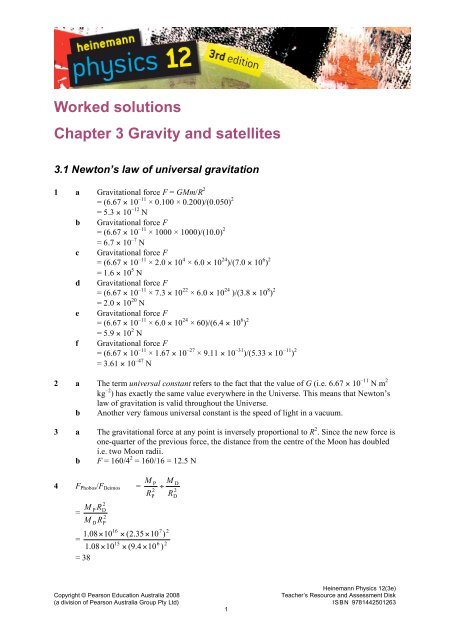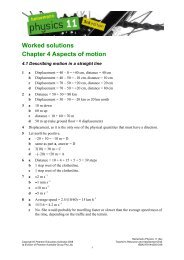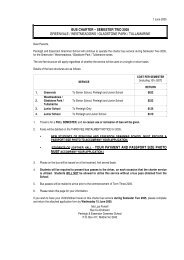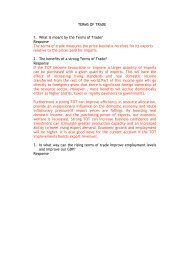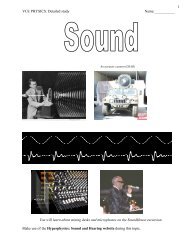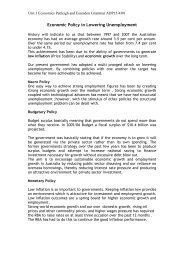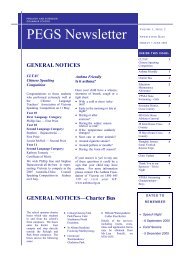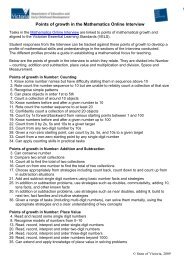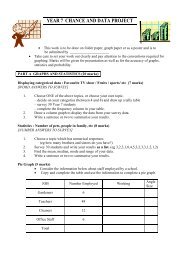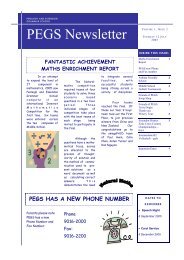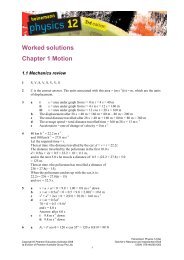Worked solutions Chapter 3 Gravity and satellites - PEGSnet
Worked solutions Chapter 3 Gravity and satellites - PEGSnet
Worked solutions Chapter 3 Gravity and satellites - PEGSnet
You also want an ePaper? Increase the reach of your titles
YUMPU automatically turns print PDFs into web optimized ePapers that Google loves.
<strong>Worked</strong> <strong>solutions</strong><strong>Chapter</strong> 3 <strong>Gravity</strong> <strong>and</strong> <strong>satellites</strong>3.1 Newton’s law of universal gravitation1 a Gravitational force F = GMm/R 2= (6.67 × 10 –11 × 0.100 × 0.200)/(0.050) 2= 5.3 × 10 –12 Nb Gravitational force F= (6.67 × 10 –11 × 1000 × 1000)/(10.0) 2= 6.7 × 10 –7 Nc Gravitational force F= (6.67 × 10 –11 × 2.0 × 10 4 × 6.0 × 10 24 )/(7.0 × 10 6 ) 2= 1.6 × 10 5 Nd Gravitational force F= (6.67 × 10 –11 × 7.3 × 10 22 × 6.0 × 10 24 )/(3.8 × 10 8 ) 2= 2.0 × 10 20 Ne Gravitational force F= (6.67 × 10 –11 × 6.0 × 10 24 × 60)/(6.4 × 10 6 ) 2= 5.9 × 10 2 Nf Gravitational force F= (6.67 × 10 –11 × 1.67 × 10 –27 × 9.11 × 10 –31 )/(5.33 × 10 –11 ) 2= 3.61 × 10 –47 N2 a The term universal constant refers to the fact that the value of G (i.e. 6.67 × 10 –11 N m 2kg –2 ) has exactly the same value everywhere in the Universe. This means that Newton’slaw of gravitation is valid throughout the Universe.b Another very famous universal constant is the speed of light in a vacuum.3 a The gravitational force at any point is inversely proportional to R 2 . Since the new force isone-quarter of the previous force, the distance from the centre of the Moon has doubledi.e. two Moon radii.b F = 160/4 2 = 160/16 = 12.5 N4 F Phobos /F Deimos ==MMPDRR2D2P161.08!10=1.08 ! 10= 3815M M ÷R RP2P! (2.35 ! 10! (9.4 ! 1067))22D2DHeinemann Physics 12(3e)Copyright © Pearson Education Australia 2008Teacher’s Resource <strong>and</strong> Assessment Disk(a division of Pearson Australia Group Pty Ltd) ISBN 97814425012631
<strong>Worked</strong> <strong>solutions</strong><strong>Chapter</strong> 3 <strong>Gravity</strong> <strong>and</strong> <strong>satellites</strong>3.2 Gravitational fields1 Mercury: g = GM/R 2= (6.67 × 10 –11 × 3.30 × 10 23 )/(2.44 × 10 6 ) 2= 3.70 N kg –1Saturn: g = GM/R 2= (6.67 × 10 –11 × 5.69 × 10 26 )/(6.03 × 10 7 ) 2= 10.4 N kg –1Jupiter: g = GM/R 2= (6.67 × 10 –11 × 1.90 × 10 27 )/(7.15 × 10 7 ) 2= 24.8 N kg –12 a F g = mg = 80 × 3.70 = 300 Nb F g = mg = 80 × 10.4 = 830 Nc F g = mg = 80 × 24.8 = 2.0 × 10 3 N3 While Saturn is about 100 times more massive than Earth, this is offset by Saturn having about10 times the radius of Earth. Gravitational field strength increases with mass, but decreases withdistance from the centre of the planet.4 g = 9.8 /4.0 2= 0.61 N kg –15 Acceleration = 0.61 m s –26 Acceleration at 4.0R E /acceleration at 2.0R E = g(4R E )/g(2R E )= (2.0/4.0) 2 = 1:4 = 0.257 g = GM/R 2= (6.67 × 10 –11 × 3.0 × 10 30 )/(10 × 10 3 ) 2= 2.0 × 10 12 N kg –18 g = GM/R 2= (6.67 × 10 –11 × 3.0 × 10 30 )/(5.0 × 10 6 ) 2= 8.0 × 10 6 N kg –19 Acceleration = g = 8.0 × 10 6 m s –210 The gravimeter would respond to differences in the gravitational field strength in a particularregion due to either large deposits of low-density material (e.g. oil) or large deposits of highdensitymaterial (e.g. iron ore).11 a F = GMm/R 2= (6.67 × 10 –11 × 7.3 × 10 22 × 500)/(3.0 × 10 6 ) 2 = 270 Nb ΣF = mga = g = ΣF/m = 270/500 = 0.54 m s –2c F = GMm/R 2= (6.67 × 10 –11 × 7.3 × 10 22 × 50)/(3.0 × 10 6 ) 2 = 27 Nd ΣF = mga = g = ΣF/m = 27/50 = 0.54 m s –2e g = 0.54 N kg –1Heinemann Physics 12(3e)Copyright © Pearson Education Australia 2008Teacher’s Resource <strong>and</strong> Assessment Disk(a division of Pearson Australia Group Pty Ltd) ISBN 97814425012633
<strong>Worked</strong> <strong>solutions</strong><strong>Chapter</strong> 3 <strong>Gravity</strong> <strong>and</strong> <strong>satellites</strong>12 Let x = required distanceThen 6.0 × 10 24 /x 2= 7.3 × 10 22 /(3.8 × 10 8 – x) 2<strong>and</strong> x = 3.4 × 10 8 mHeinemann Physics 12(3e)Copyright © Pearson Education Australia 2008Teacher’s Resource <strong>and</strong> Assessment Disk(a division of Pearson Australia Group Pty Ltd) ISBN 97814425012634
<strong>Worked</strong> <strong>solutions</strong><strong>Chapter</strong> 3 <strong>Gravity</strong> <strong>and</strong> <strong>satellites</strong>3.4 Energy changes in gravitational fields1 C is the correct answer. A satellite in a stable circular orbit around the Earth will have a constantorbital speed <strong>and</strong> a constant radius.2 The gravitational field strength is lowest at A <strong>and</strong> greatest at D.3 The acceleration is indicated by the gravitational field strength, so it increases as the meteortravels from A to D.4 A, B <strong>and</strong> C are correct. As the meteor falls towards Earth, its gravitational potential energy istransformed into kinetic energy. If air resistance is ignored, mechanical energy is conserved.5 a A distance of 100 km above the Earth’s surface represents a distance from the centre ofthe Earth =100 × 10 3 + 6.4 × 10 6 = 6.5 × 10 5 m.From the graph, F = 9.2 Nb From the graph, F = 5.0 NWhen the distance from the Earth’s centre = 9.0 × 10 6 m,then height above Earth’s surface = 9.0 × 10 6 – 6.4 × 10 6 = 2.6 × 10 6 m.6 a E k = ½ mv 2= 0.5 × 1.0 × (4.0 × 10 3 ) 2 = 8.0 × 10 6 Jb The increase in kinetic energy of the rock as it moves between these two points= corresponding decrease in gravitational energy= area under the graph from R = 6.5 × 10 6 m to R = 9.5 × 10 6 m= 2.0 × 10 7 Jc ΔE k = 2.0 × 10 7 J = final E k – 8.0 × 10 6 J<strong>and</strong> the final E k = 2.8 × 10 7 Jd E k = ½ mv 2 ,then 2.8 × 10 7 J = 0.5 × 1.0v 2<strong>and</strong> v = 7.5 × 10 3 m s –1 , i.e. 7.5 km s –17 a v = √(GM/R)= [(6.67 × 10 –11 × 6.0 × 10 24 )/(7.0 × 10 6 m)] ½ = 7.6 × 10 3 m s –1 = 7.6 km s –1b E k = ½ mv 2= 0.5 × 20 × 10 3 × (7.6 × 10 3 ) 2= 5.7 × 10 11 Jc T = 2πR/v= (2π × 7.0 × 10 6 )/7.6 × 10 3= 5.8 × 10 3 s8 a v = √(GM/R) = [(6.67 × 10 –11 × 6.0 × 10 24 )/(9.0 × 10 6 )] ½ = 6.7 km s –1b E k = ½ mv 2 = 0.5 × 20 × 10 3 × (6.67 × 10 3 ) 2 = 4.4 × 10 11 Jc T = 2πR/v= 2π × 9.0 × 10 6 /6.67 × 10 3= 8.5 × 10 3 sHeinemann Physics 12(3e)Copyright © Pearson Education Australia 2008Teacher’s Resource <strong>and</strong> Assessment Disk(a division of Pearson Australia Group Pty Ltd) ISBN 97814425012637
<strong>Worked</strong> <strong>solutions</strong><strong>Chapter</strong> 3 <strong>Gravity</strong> <strong>and</strong> <strong>satellites</strong>9 The increase in gravitational energy per kilogram of the satellite as it moved from its lower orbitto its higher orbit is equal to the area under the graph between R = 7.0 × 10 3 km to R = 9.0 × 10 3kmArea = 25 squares × 1.0 × 0.5 × 10 6 = 1.25 × 10 7 J kg-1Increase in gravitational potential energy = area × mass = 1.25 × 10 7 × 20 000 = 2.5 × 10 11 J.10 The initial kinetic energy of the satellite when it was launched = the increase in gravitationalpotential energy of the satellite from R = 7.0 × 10 3 km to R = 8.0 × 10 3 km.From the graph, the increases in gravitational potential energy of a 1.0 kg mass that has movedbetween these two points = area under graph = 7.08 × 10 3 JThen for a 240 kg satellite the corresponding area = 240 × 7.08 × 10 3 J)= 1.7 × 10 9 JHeinemann Physics 12(3e)Copyright © Pearson Education Australia 2008Teacher’s Resource <strong>and</strong> Assessment Disk(a division of Pearson Australia Group Pty Ltd) ISBN 97814425012638
<strong>Worked</strong> <strong>solutions</strong><strong>Chapter</strong> 3 <strong>Gravity</strong> <strong>and</strong> <strong>satellites</strong>3.5 Apparent weight <strong>and</strong> weightlessness1 a Weight F g = mg = 0.15 × 9.8 = 1.5 Nb Mass = 0.15 kg2 The toy <strong>and</strong> Gracie’s h<strong>and</strong> both move with an acceleration of 9.8 m s –2 down <strong>and</strong> so the normalforce on the toy is zero.3 The toy would continue to move with an acceleration of 9.8 m s –2 down <strong>and</strong> so would movewith the same motion as Gracie. It would stay in the same position relative to her.4 a Weight F g = mg = 50 × 9.8 = 490 Nb ∑F = ma = 490 N downF g = 490 N down, so the normal force is zeroc Her apparent weight is the same as the normal force i.e. zero.5 a The weight of the girl is not zero, but she perceives her weight as zero because she feelszero reaction force from the seat during the plummet. True weightlessness only occurswhen the gravitational field strength is zero. This only happens in deep space.b Their acceleration must equal g.6 a Weight F g = mg = 90 × 9.8 = 880 N downb ∑F = ma = 90 × 35 = 3150 = 3.2 kN upc ∑F = F N +F gF N = ∑F – F g = 3150↑ – 880↓ = 4030 = 4.0 kN7 a g = GM/R 2 = 6.67 × 10 –11 × 6.0 × 10 24 /(6.8 × 10 6 ) 2 = 8.7 N kg –1b F g = mg = 60 × 8.7 = 520 N8 a v = √(GM/R) = √(6.67 × 10 –11 × 6.0 × 10 24 /6.8 × 10 6 ) = 7700 m s –1 = 7.7 km s –1b a = g = 8.7 m s –2c ∑F = ma = 60 × 8.7 = 520 N down9 This comment is incorrect since the gravitational field strength is not zero. A better commentwould be ‘the astronaut is experiencing apparent weightlessness’.10 The spacecraft <strong>and</strong> the astronaut are both moving with an acceleration that is equal to thegravitational field strength <strong>and</strong> so the astronaut will experience zero normal force from thespace-craft.Heinemann Physics 12(3e)Copyright © Pearson Education Australia 2008Teacher’s Resource <strong>and</strong> Assessment Disk(a division of Pearson Australia Group Pty Ltd) ISBN 97814425012639
<strong>Worked</strong> <strong>solutions</strong><strong>Chapter</strong> 3 <strong>Gravity</strong> <strong>and</strong> <strong>satellites</strong><strong>Chapter</strong> review1 F = GMm/R 2then R 2 = GMm/F= (6.67 × 10 –11 × 5.69 × 10 26 × 1.05 × 10 21 )/(2.79 × 10 20 )<strong>and</strong> R = 3.78 × 10 8 m2 At a height of 2 Earth radii above the Earth’s surface, a person is a distance of 3 Earth radiifrom the centre of the Earth.Then F = 900/3 2 = 900/9 = 100 N so D.3 a ∑F = F N +F gF N = ∑F – F g = 2400↑ – 780↓ = 3200N ↑ so Db The normal force is about 4 times greater than usual, so the astronaut will feel about 4times heavier, so B.c Weight F g = mg = 80 × 9.8 = 780 N, so C.d During orbit, the astronaut travels with an acceleration of 8.2 m s –2 <strong>and</strong> so is in free-fall.F N = 0, so A.e Weight F g = mg = 80 × 8.2 = 660 N, so D.4 M/(0.8R) 2 = m/(0.2R) 2<strong>and</strong> M/m = 1/4 2 = 1 : 16 = 0.0635 a g = GM/R 2= (6.67 × 10 –11 × 1.02 × 10 26 )/(2.48 × 10 7 ) 2= 11.1 N kg –1b C, it will accelerate at a rate given by the gravitational field strength, i.e. at 11.1 m s –26 The orbital speed of the Moon around the Earth is given by:v = √(GM/R)= [(6.67 × 10 –11 × 5.98 × 10 24 )/(3.84 × 10 8 )] ½= 1.02 × 10 3 m s –1The period of the Moon around the Earth T = 2πR/v= 2π × 3.84 × 10 8 /(1.02 × 10 3 )= 2.367 × 10 6 s= 2.367 × 10 6 / (60 × 60 × 24) = 27.4 days7 a v = √(GM/R)= [(6.67 × 10 –11 × 1.90 × 10 27 )/1.10 × 10 10 ] ½ = 3.39 × 10 3 m s –1b a = v 2 /R= (3.39 × 10 3 ) 2 /(1.10 × 10 10 )= 1.05 × 10 –3 m s –2 towards Jupiterc T = 2πR/v= 2π × 1.10 × 10 10 /3.39 × 10 3= 2.048 × 10 7 s = 2.048 × 10 7 / (60 × 60 × 24) = 235 days8 a C, a satellite is said to be in a geosynchronous orbit if its orbital period is the same as thatof the Earth’s rotation (i.e. 24 hours or 86 400 s).b This satellite will always be directly above the same point on the Earth’s surface, <strong>and</strong> cantherefore transmit radio signals to any point that can see it.c R 3 = GMT 2 /4π 2 ,Heinemann Physics 12(3e)Copyright © Pearson Education Australia 2008Teacher’s Resource <strong>and</strong> Assessment Disk(a division of Pearson Australia Group Pty Ltd) ISBN 978144250126310
<strong>Worked</strong> <strong>solutions</strong><strong>Chapter</strong> 3 <strong>Gravity</strong> <strong>and</strong> <strong>satellites</strong>then R 3 = (6.67 × 10 –11 × 6.0 × 10 24 × 86400) 2 /4π 2<strong>and</strong> R = 4.2 × 10 7 m9 a R 3 = GMT 2 /4π 2= (6.67 × 10 –11 × 3.30 × 10 23 × (5.07 × 10 6 ) 2 /4π 2<strong>and</strong> R = 2.43 × 10 8 mb v = 2πR/T= 2π × 2.43 × 10 8 /(5.07 × 10 6 ) = 301 m s –1c a = v 2 /r= (301) 2 /(2.429 × 10 8 ) = 3.73 × 10 –4 m s –2 towards Mercury10 a The increase in the kinetic energy of the rock= area under the graph from R = 2.5 × 10 6 m to R = 3.0 × 10 6 m= 5.6 squares × 10 × 0.5 × 10 6=2.8 × 10 7 Jb The initial E k = ½ mv 2= 0.5 × 20 × (1.0 × 10 3 ) 2 = 1.0 × 10 7 JThe final E k = 2.8 × 10 7 J + 1.0 × 10 7 J = 3.8 × 10 7 Jc 3.8 × 10 7 J = 0.5 × 20v 2<strong>and</strong> v = 1.9 × 10 3 m s –1d At r = 2.5 × 10 6 m, F g = 70 N = mgg = 70/20 = 3.5 N kg –111 a (T 1 /T 2 ) 2 = (R 1 /R 2 ) 3<strong>and</strong> T 1 /T 2 = (R 1 /2R) 3/2 = 1/8 so Db v 1 /v 2 = (2πR 1 /T 1 )/(2πR 2 /T 2 ) = (T 2 /T 1 )(R 1 /R 2 ) = 8 /2 = 2 , so B.c a 1 /a 2 = (v 2 1 /R 1 )/(v 2 2 /R 2 ) = 2 × 2 = 4, so D.12 Transposing GMm/R 2 = 4π 2 Rm/T 2 to make M the subject gives: M = 4π 2 R 3 m/GT 2 .Substituting into this using R = 1.5 × 10 11 m <strong>and</strong> T = 365.25 × 24 × 60 × 60 gives M =2.0×10 30 kg.13 From graph, when distance = 300 km = 3.0 × 10 5 m, g = 9.0 N kg –114 D is correct. Area units are: N kg –1 × m = N m kg –1 = J kg –115 C is the correct answer. The area under the graph gives the energy change per kilogram. In thisexample, the satellite is falling closer to Earth, so it is losing gravitational potential energy.16 This can be determined by finding the area under the graph between R = 2 × 10 5 m <strong>and</strong>R = 6 × 10 5 m.Counting squares give area = 35 × 1.0 × 1.0 × 10 5 = 3.5 × 10 6 J kg-1Energy = mass × area = 1000 × 3.5 × 10 6 = 3.5 × 10 9 J17 No, air resistance would mean that a significant amount of kinetic energy would be transformedinto heat energy.18 D, the mass of the moons would need to be known before the forces can be compared.19 Charon: T 2 /R 3 = 6.4 2 /1960 3 = 5.0 × 10 –9Nix: T 2 /R 3 = 5.0 × 10 –9Heinemann Physics 12(3e)Copyright © Pearson Education Australia 2008Teacher’s Resource <strong>and</strong> Assessment Disk(a division of Pearson Australia Group Pty Ltd) ISBN 978144250126311
<strong>Worked</strong> <strong>solutions</strong><strong>Chapter</strong> 3 <strong>Gravity</strong> <strong>and</strong> <strong>satellites</strong>T 2 /4400 3 = 5.0 × 10 –9T = √ (5.0 × 10 –9 × 4400 3 ) = 21.5 days2GMm 4!Rm20 F = =22R TTransposing to make M the subject gives:234!RM = = 1.3 × 10 22 kg2GTHeinemann Physics 12(3e)Copyright © Pearson Education Australia 2008Teacher’s Resource <strong>and</strong> Assessment Disk(a division of Pearson Australia Group Pty Ltd) ISBN 978144250126312
<strong>Worked</strong> <strong>solutions</strong><strong>Chapter</strong> 3 <strong>Gravity</strong> <strong>and</strong> <strong>satellites</strong>Exam-style questions (Motion in one <strong>and</strong> twodimensions)1 ΔU g = area under graph = 8.5 squares = 8.5 × 1.0 × 10 4 × 0.4 × 10 6 = 4.3 × 10 10 J2 At 600 km: E k = ½ mv 2 = 0.5 × 10 000 × 1500 2 = 1.1 × 10 10 JSo E k at 100 km = 1 × 10 10 + 4.3 × 10 10 = 5.3 × 10 10 J½ mv 2 = 5.3 × 10 100.5 × 10 000v 2 = 5.3 × 10 10v = 3.3 × 10 3 m s –13 a r = 6400 + 3600 = 10 000 km = 10 × 10 6 mF g = 4.0 × 10 4 N (from graph)b r = 6.0 × 10 5 + 6.4 × 10 6 = 7.0 × 10 6 mF g = 8.1 × 10 4 N (from graph)4 At 600 km, F g = 8.1 × 10 4 N, so a = F g /m = 8.1 m s –2At 100 km, F g = 9.2 × 10 4 N, so a = F g /m = 9.2 m s –2The acceleration increases from 8.1 m s –2 to 9.2 m s –25 Distance = area = 3350 m = 3.4 km6 a Cb This section has the largest acceleration.7 From 10–40 s <strong>and</strong> 60–80 s8 Never9 unbalanced, balanced10 v = 2πr/T = 2 × π × 5.00/2.50 = 12.6 m s –111 a = v 2 /r = 31.6 m s –212 F N = ΣF = ma = 60 × 31.6 = 1.89 × 10 3 N13 T = 10.0/6 = 1.67f = 1/T = 1/1.67 = 0.600 Hz14GMm 4!Rm=22R TR = (GMT 2 /4π 2 ) 1/3= (1.25 × 10 23 ) 1/3= 5.0 × 10 7 m215 v = 2πr/T = 2 × π × 5.0 × 107/(0.31 × 86 400) = 1.17 × 10 4 m s –1 =11.7 km s –116 Thalassa: T 2 /R 3 = 0.31 2 /(5.0 × 10 7 ) 3 = 7.69 × 10 –25Proteus: T 2 /R 3 = 7.69 × 10 –25Heinemann Physics 12(3e)Copyright © Pearson Education Australia 2008Teacher’s Resource <strong>and</strong> Assessment Disk(a division of Pearson Australia Group Pty Ltd) ISBN 978144250126313
<strong>Worked</strong> <strong>solutions</strong><strong>Chapter</strong> 3 <strong>Gravity</strong> <strong>and</strong> <strong>satellites</strong>1.1 2 /R 3 = 7.69 × 10 –25R = √1.57 × 10 34 = 1.16 × 10 8 m17 At maximum height: v = 0, a = –9.8 m s –2 , t = 1.0 s, x = ?x = vt = ½ at 2 = 0 =0.5 × –9.8 × 1.0 2 = 4.9 m18 9.8 m s –2 down19 H: v = x/t = 8.0/2.0 = 4.0 m s –1V: v = 0, a = -9.8 m s –2 , t = 1.0 s, u = ?v = u + at0 = u – 9.8 × 1.0u = 9.8 m s –1Use Pythagoras to find actual speed at launch: v = √(4.0 2 + 9.8 2 ) = √112 = 11 m s –120 D, if air resistance is ignored, the only force acting is the gravitational force.21 Δp = p f – p i = (0.20 × 30 south) – (0.20 × 20 north) = 6.0 kg m s –1 south – 4.0 kg m s –1 north =10 kg m s –1 south22 Impulse = Δp = 10 N s south23 a ΣFΔt = ΔpΣF = 1.0 ! 10 3 N southb Using Newton’s third law, the average force that the ball exerts on the bat is 1.0 ! 10 3 Nnorth.24 C <strong>and</strong> E are correct. The area under a force–time graph represents impulse or change inmomentum.25 At 300 km, g = 3.0 N kg –1F g = mg = 20 × 3.0 = 60 N26 Area = 9 squares = 9 × 1.0 × 2.0 × 10 5 = 1.8 × 10 6 J kg-1ΔE k = area × mass = 1.8 × 10 6 × 20 = 3.6 × 10 7 J27 Determine the energy associated with each grid square by multiplying each area by the mass of20 kg. Calculate altitude at which total area starting from zero height is equal to 40 MJ.28 W(by prospector) = F P × d = 100 × 20 = 2.0 × 10 3 N m29 W(on trolley) = ΣF × d = 70 × 10 = 1.4 × 10 3 N m30 ΔE k =1.4 × 10 3 J31 ΔE k =1.4 × 10 3 J½ mv 2 = 1.4 × 10 3v 2 = 14v = 3.7 m s –132 W(friction) = F f × d = 30 × 20 = 600 J33 P = W(by prospector)/time = 2.0 × 10 3 /10 = 200 WHeinemann Physics 12(3e)Copyright © Pearson Education Australia 2008Teacher’s Resource <strong>and</strong> Assessment Disk(a division of Pearson Australia Group Pty Ltd) ISBN 978144250126314
<strong>Worked</strong> <strong>solutions</strong><strong>Chapter</strong> 3 <strong>Gravity</strong> <strong>and</strong> <strong>satellites</strong>34 U s = ½ kx 2 = 0.5 × 150 × (0.075) 2 = 0.42 J35 v ISS /v O = √(GM/R ISS )/ √(GM/R O ) = √(R O /R ISS ) = √(4.24 × 10 7 /6.78 × 10 6 ) = 2.52GMm 4!Rm36 F = =22R TTransposing to make T the subject gives:T = √(4π 2 R 3 /GM)T ISS /T O = √(R 3 ISS /R 3 O ) = √(4.1 × 10 –3 ) = 0.06437 a ISS /a O = (GM/R ISS 2 )/(GM/R O 2 ) = R O 2 / R ISS 2 = (4.24 × 10 7 ) 2 /(6.78 × 10 6 ) 2 = 39.13839 k = gradient ≈ 20 N m –140 U s = ½ kx 2 = 0.5 × 20 × 15 2 = 2.3 × 10 3 J41 C, the force is becoming smaller so acceleration will decrease.42 E k = ½ mv 2 = 22500.5 × 60 × v 2 = 2250v = √75 = 8.7 m s –143 Σp i = Σp f(6.0 × 120) + 0 = (120 + 45) × v cv c = 4.4 m s –144 Δp = p f – p i = (120 × 4.4) – (120 × 6.0) = – 200 kg m s –1The ruckman loses 200 kg m s –1 of momentum.45 In this collision, the momentum gain of the bag is equal to the momentum loss of the ruckman,i.e. 200 kg m s –1 .46 inelastic, momentum, kinetic energy47 a a = v 2 /r = 6.0 2 /2.0 = 18 m s –2 upb ∑F = ma = 55 × 18 = 990 N ↑Heinemann Physics 12(3e)Copyright © Pearson Education Australia 2008Teacher’s Resource <strong>and</strong> Assessment Disk(a division of Pearson Australia Group Pty Ltd) ISBN 978144250126315
<strong>Worked</strong> <strong>solutions</strong><strong>Chapter</strong> 3 <strong>Gravity</strong> <strong>and</strong> <strong>satellites</strong>F g = mg = 55 × 9.8 = 539 N ↓∑F = F N + F gF N = ∑F – F g = 990 N ↑ – 539 N ↓ = 1529 N ↑ = 1.5 × 10 3 N up48 The apparent weight is given by the normal force of 1350 N. This is almost three times largerthan the weight force <strong>and</strong> so the skater would feel much heavier than usual.4950 a Cb One force acts on the floor <strong>and</strong> the other force acts on the ball. These forces are equal inmagnitude as described in Newton’s third law.Heinemann Physics 12(3e)Copyright © Pearson Education Australia 2008Teacher’s Resource <strong>and</strong> Assessment Disk(a division of Pearson Australia Group Pty Ltd) ISBN 978144250126316


